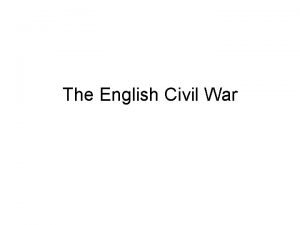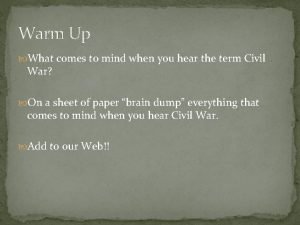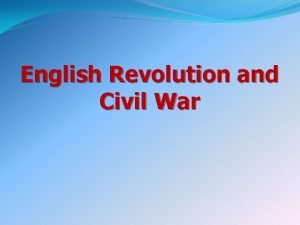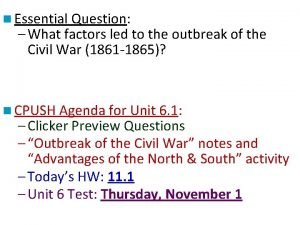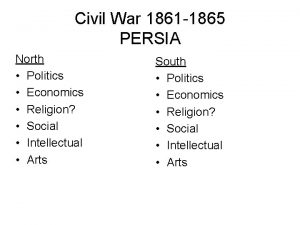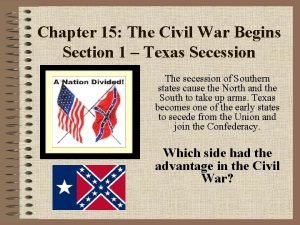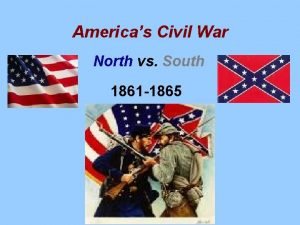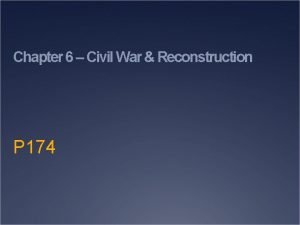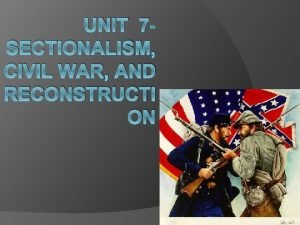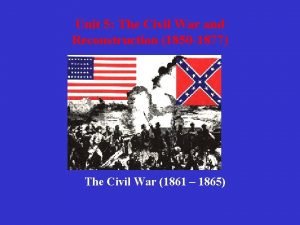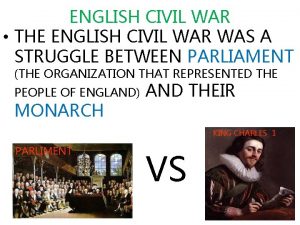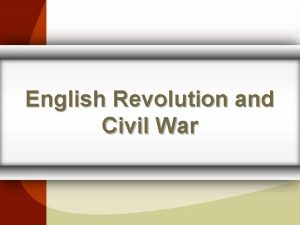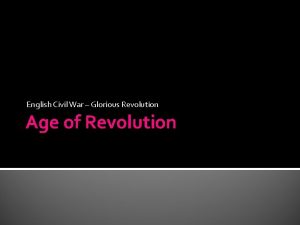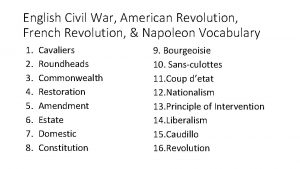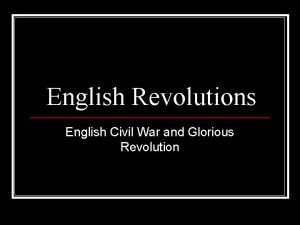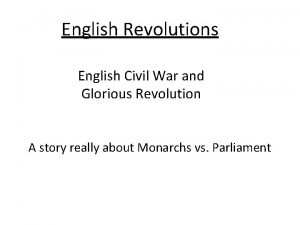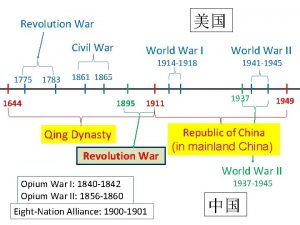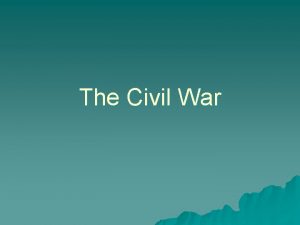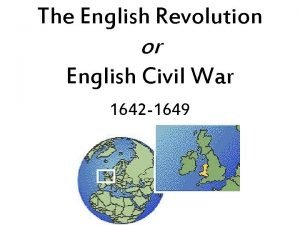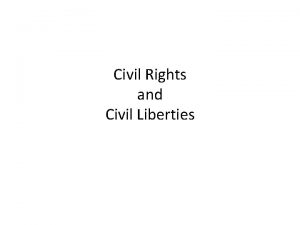English Revolution and Civil War James I of











![King James II [r. 1685 -1688] Was a bigoted convert to Catholicism without any King James II [r. 1685 -1688] Was a bigoted convert to Catholicism without any](https://slidetodoc.com/presentation_image_h/2b67df86b3c7b56803b5666f21370c5d/image-12.jpg)
![King James II [r. 1685 -1688] Introduced Catholics into the High Command of both King James II [r. 1685 -1688] Introduced Catholics into the High Command of both](https://slidetodoc.com/presentation_image_h/2b67df86b3c7b56803b5666f21370c5d/image-13.jpg)
![The “Glorious” Revolution [1688] Whig & Tory leaders offered the throne jointly to James The “Glorious” Revolution [1688] Whig & Tory leaders offered the throne jointly to James](https://slidetodoc.com/presentation_image_h/2b67df86b3c7b56803b5666f21370c5d/image-14.jpg)


- Slides: 16

English Revolution and Civil War

James I of England Scottish Catholic who believed in the “Divine Right” to rule as he pleased. James I told Parliament: “The state of monarchy is the supremest thing upon earth; for kings are not only God’s lieutenants upon earth and sit upon God’s throne, but even by God himself, they are called gods. ”

Causes of the English Civil War Charles I became King in 1625 He spent lots of money Believed in divine right Forced landowners to loan him money Established martial law in much of England

Charles I vs. Parliament Charles I Ruled without summoning parliament for 11 years. Parliament created a Petition of Rights. 1. No billeting – forcing people to house troops 2. No martial law 3. No arbitrary tax 4. No arbitrary jailing

Picking Sides �The country split between supporters of the King called Royalists… �and supporters of Parliament called Puritans or Roundheads.

Lifestyles of Puritans and Royalists Puritans Royalists No dancing Wild parties No gambling Loose morals Censorship Drinking No pubs Swearing No races or rooster fights Spending lots of money No actors or minstrels Ceremonies and elaborate decorations

Puritans �Called “roundheads” because they didn’t wear wigs and had close cut hair. �Orange was a protestant color, so it became a puritan color. Royalists �Members of the army were called “cavaliers” – belonged to the cavalry �Green was a catholic color, so it became a royalist color

Oliver Cromwell Dictator or Saviour? Came from a poor, Puritan family Educated at Cambridge Member of the House of Commons

Policies of Cromwell: “The Lord Protector” �The civil war begins with Charles I ignoring and then trying to arrest his Parliament. �Cromwell begins as a mild member of parliament and loyal servant of the King. �Charles was captured and tried for treason in 1649. �He refused to recognize the court, but was found guilty anyway. �By the end of the war: � King Charles I is dead (regicide) � Parliament has been taken by force by Cromwell in 1653.

The Restoration: The Return of the King Charles II, son of Charles I, is invited to rule England. (The Merry Monarch) The Earl of Rochester wrote about Charles II, “Here lies our sovereign Lord the King, Whose promises none relies on; He never said a foolish thing, Nor ever did a wise one. ” Charles II replied, “This is very true, for my words are my own, and my actions are those of my ministers. ”

Problems that Charles II Faced �Charles learned from his father’s mistakes and worked with Parliament, so most people liked him. But… �Charles had many girlfriends, but no legitimate heir. So…when he died, his openly-Catholic brother James II will be king (Parliament's worst fear!!)
![King James II r 1685 1688 Was a bigoted convert to Catholicism without any King James II [r. 1685 -1688] Was a bigoted convert to Catholicism without any](https://slidetodoc.com/presentation_image_h/2b67df86b3c7b56803b5666f21370c5d/image-12.jpg)
King James II [r. 1685 -1688] Was a bigoted convert to Catholicism without any of Charles II’s shrewdness or ability to compromise. Alienated even the Tories. Provoked the revolution that Charles II had succeeded in avoiding!
![King James II r 1685 1688 Introduced Catholics into the High Command of both King James II [r. 1685 -1688] Introduced Catholics into the High Command of both](https://slidetodoc.com/presentation_image_h/2b67df86b3c7b56803b5666f21370c5d/image-13.jpg)
King James II [r. 1685 -1688] Introduced Catholics into the High Command of both the army and navy. Surrounded himself with Catholic advisors & attacked Anglican control of the universities. Claimed the power to suspend or dispense with Acts of Parliament. 1687 Declaration of Liberty of Conscience He extended religious toleration without Parliament’s approval or support.
![The Glorious Revolution 1688 Whig Tory leaders offered the throne jointly to James The “Glorious” Revolution [1688] Whig & Tory leaders offered the throne jointly to James](https://slidetodoc.com/presentation_image_h/2b67df86b3c7b56803b5666f21370c5d/image-14.jpg)
The “Glorious” Revolution [1688] Whig & Tory leaders offered the throne jointly to James II’s daughter Mary [raised a Protestant] & her husband, William of Orange. He was a vigorous enemy of Louis XIV. He was seen as a champion of the Protestant cause.

The Glorious Revolution No violence William and Mary had a blood right to the Throne. Parliament invited William and Mary to rule. Finally, freedom and civil rights.

English Bill of Rights Parliament must meet every year Only parliament can levy taxes Fair/speedy trial for all, by jury Right to petition
 Chapter 16 lesson 2 challenges to slavery
Chapter 16 lesson 2 challenges to slavery Why was the civil war considered the first modern war
Why was the civil war considered the first modern war English civil war timeline
English civil war timeline English civil war mind map
English civil war mind map Causes of the english civil war
Causes of the english civil war Civil rights and civil liberties webquest
Civil rights and civil liberties webquest Cotton diplomacy
Cotton diplomacy Unit 4 civil war and reconstruction
Unit 4 civil war and reconstruction Civil war and reconstruction study guide
Civil war and reconstruction study guide Civil war advantages and disadvantages chart
Civil war advantages and disadvantages chart States rights
States rights North and south states civil war
North and south states civil war North and south states civil war
North and south states civil war Chapter 6 civil war and reconstruction
Chapter 6 civil war and reconstruction Remembering dred scott achieve 3000
Remembering dred scott achieve 3000 Civil war ppt and guided notes
Civil war ppt and guided notes Unit 5 civil war and reconstruction
Unit 5 civil war and reconstruction


